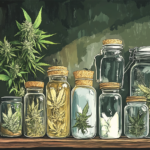NEW YORK – The average price for a pound of cannabis flower fell 8.1 percent nationally in 2023 to around $995, but cultivators in Alaska, Ohio, and Missouri still enjoy the hefty wholesale prices from a largely bygone era.
According to a new report from Leaflink, Alaska leads the country with an average wholesale flower price of $2,374.74 per pound, followed by Ohio at $2,282.70 and Missouri at $2,065.88. It’s worth noting the report presents Ohio’s pricing data in grams to align with how the “unique market operates.” As a result, Leaflink excluded Ohio from its flower price ranking but provided mg Magazine with equalized figures.
The report covers wholesale pricing from 2022 to 2023 for cartridges, concentrates, edibles, flower and pre-rolls in fourteen U.S. states and territories. While Alaska has a small lead in the flower category, it also leads the country in wholesale pricing for every other product category. Oklahoma sits at the other end of the spectrum as the least expensive state, with the country’s lowest prices for concentrates and cartridges.
Flower price per pound 2023
- Arizona: $816.55
- Colorado: $835.37
- California: $844.10
- Michigan: $901.88
- Nevada: $981.44
- Oklahoma: $1,030.76
- Oregon: $1,046.94
- Massachusetts: $1,129.27
- Puerto Rico: $1,159.41
- Washington: $1,178.19
- Arkansas: $1,457.18
- Missouri: $2,065.88
- Ohio: $2,282.70
- Alaska: $2,374.74
The Oklahoma medical market has been plagued by oversupply issues for several years. The state’s licensing craze reached a crescendo in 2021 with 9,400 cultivation licenses, 2,519 dispensaries, and 1,712 processors to serve 384,500 patients. To combat the issue, in 2022 the state legislature passed a moratorium on new dispensary, grower, and processor licenses. The moratorium will be in effect until Aug. 1, 2026. The latest license report published by the Oklahoma Medical Marijuana Authority (OMMA) shows 3,940 grows, 2,165 dispensaries, 1,145 processors and 347,156 patients.
According to a June report by the OMMA, cultivators in the state produce 64 times more biomass than needed to meet legal demand. When product is not sold it’s often stockpiled, driving prices down and incentivizing some growers to find alternative, illegal avenues to move flower out of the state, where it fetches much higher prices.
“Oklahoma should blame other states that have made it so difficult for legal weed to survive,” said Robin Goldstein, professor of agricultural economics at the University of California, Davis, and co-author of Can Legal Weed Win? “Illegal growers in Oklahoma are only able to thrive and exist because, in those other states, legal weed is so expensive.”
According to local news reports, the Oklahoma Bureau of Narcotics and Dangerous Drugs has traced cannabis grown in Oklahoma to nearly every state and is currently investigating “thousands” of farms believed to be operated by foreign criminal organizations.
The largest state by land area, Alaska has one of the country’s smallest cultivation footprints with 161 active cultivation licenses split about evenly between regular and limited (500 square feet maximum) licenses, including those with “active-pending inspection” status. While there’s one cultivator for every 88 patients in Oklahoma, there’s nearly one cultivator for every 2,550 adults aged 21 and older in Alaska. It may be shortsighted to compare medical and adult-use markets with such stark differences in the potential customer pools, but it’s difficult to ignore how the basic economic concept of supply and demand is playing out in both states.
Ohio stands apart as another odd market, and not just because it measures cannabis in grams instead of pounds at wholesale. While Ohio’s flower data was not included as part of Leaflink’s published state rankings, Headset’s latest retail sales data snapshot from April 3, 2024, paints an exceedingly expensive picture.
“When comparing Ohio to other markets in the country, it is evident that Ohio’s average item price is among the highest,” the analysis states. “For instance, the average item price in Ohio is $37.42, while states like Michigan and Oregon have significantly lower prices at $11.92 and $13.8, respectively.”
The Ohio Department of Commerce lists 36 cultivator licenses and one provisional license. That means there’s roughly one cultivator for every 13,900 potential adult-use customers in the state—an enviable ratio for legal cultivators across the country.













[…] large-scale grows are operating), wholesale prices have settled in a low range. As of mid-2024, spot indexes put Colorado flower around $800 per pound, far below the $1,500+lb seen in the mid-2010s. […]
[…] to maximized yields and quality. Efficiency is not merely a goal; it is a necessity in the competitive world of cultivation. Accurate forecasting is a powerful tool that equips cultivators with the ability to make informed […]
[…] Wholesale Flower Tops $2K per Pound in 3 States […]